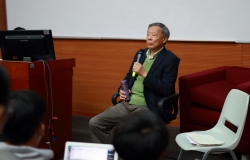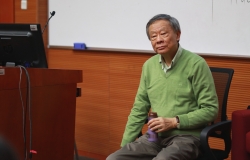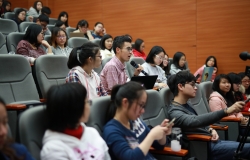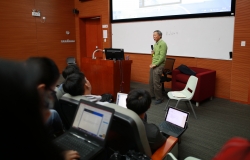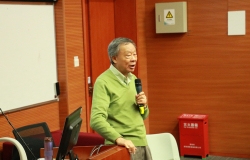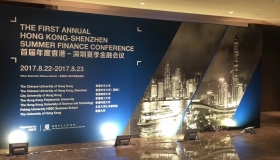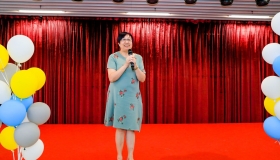Diligentia et Sapientia | Shanghai: From Past into Present
November 30th, 2016 saw the 1st Diligentia et Sapientia with all seats occupied. It is a great honor for Diligentia College to have invited Prof. Leo Ou-fan Lee, author of “Shanghai Modern: The Flowering of a New Urban Culture in China, 1930-1945”, with his wonderful speech Shanghai: From Past into Present.

 The lecture started from points of students’ interest, carrying out creative analysis and reflection on “Shanghai Modern” and progressive discussions with students on the “nostalgia” and Shanghai “cosmopolitanism” issue. In Prof. Lee’s opinion, one major common ground between Petersburg and Vienna is their own flaunt of “cultural city”. With old architectures and cultures as well as people’s respect, the two cities in the 21st century remain roughly the same as in the 19th century. Although Chinese cities enjoy much longer history than these, we have paid much less attention to the urban culture than the west. Relevant to Chinese “nostalgia”, disjointed images and totally different views can be seen in the present Xi’an and the past Chang’an. The countryside is the cultural and aesthetic keynote of China, as evidenced by Tang Poems and Song ci-poems. However, people raise themselves to the national level after discussing it and cities seem nonexistent under the traditional value “organic whole of family and state”. In fact, the West is the mainstream of a cultural urban relation. Next, Prof. Lee mentioned Shanghai. In the semi-colonial period, capitalist countries in the west started to set up ports in China, among which Shanghai was one of the most significant. Prof. Lee thought that such treaty ports were new models of the West, isolated from Chinese traditional aesthetics based on the countryside. Therefore, Ordinary people looked down upon such a Shanghai where foreign trading prospered miles within. Interestingly, however, people in Shanghai have subsequently taken possession of it as part of its culture.
The lecture started from points of students’ interest, carrying out creative analysis and reflection on “Shanghai Modern” and progressive discussions with students on the “nostalgia” and Shanghai “cosmopolitanism” issue. In Prof. Lee’s opinion, one major common ground between Petersburg and Vienna is their own flaunt of “cultural city”. With old architectures and cultures as well as people’s respect, the two cities in the 21st century remain roughly the same as in the 19th century. Although Chinese cities enjoy much longer history than these, we have paid much less attention to the urban culture than the west. Relevant to Chinese “nostalgia”, disjointed images and totally different views can be seen in the present Xi’an and the past Chang’an. The countryside is the cultural and aesthetic keynote of China, as evidenced by Tang Poems and Song ci-poems. However, people raise themselves to the national level after discussing it and cities seem nonexistent under the traditional value “organic whole of family and state”. In fact, the West is the mainstream of a cultural urban relation. Next, Prof. Lee mentioned Shanghai. In the semi-colonial period, capitalist countries in the west started to set up ports in China, among which Shanghai was one of the most significant. Prof. Lee thought that such treaty ports were new models of the West, isolated from Chinese traditional aesthetics based on the countryside. Therefore, Ordinary people looked down upon such a Shanghai where foreign trading prospered miles within. Interestingly, however, people in Shanghai have subsequently taken possession of it as part of its culture.
 Prof. Lee also mentioned that at the initial stage of his study, he strolled on the streets of Shanghai as a “Flaneur”. He found that the present Shanghai was different from Shiying Mu's glittery and colorful one——the Grand Theatre was no longer there; four big department stores were too decadent to be cared for; old Shanghai landmarks recorded in historical materials were barely seen. Therefore, he started to visit some people once living in the old Shanghai and thereby blazed new trails for his study. Prof. Lee mentioned that the significance of a culture and a city lies in creating a city of culture and humanizing the fixed, such as streets, buildings, cities, etc. And this is also the pursuit of the present Shanghai. Prof. Lee made a vivid explanation of some images of the old Shanghai. He mentioned that when Shanghai became a port of the foreign concession, its architecture and layout were also influenced by colonization. A few of the most important banks lie across the wide road beside the Bund. Heading a little further in, you can see restaurants and department stores. The United Kingdom conducted commercial colonization by offering access to missionaries and businessmen after conquering by warships. For Shanghai and Hong Kong, such a model worked in pairs with colonialism. Prof. Lee also mentioned the prevalence of pictorials, another interesting phenomenon in the old Shanghai. The fashion was driven by commercial cultures. Pictorials from London were able to reach Shanghai in a few days. Colonists intended to conduct colonization of people's mind by something easy to accept as pictorials, yet assimilated by Shanghai's local culture. Sherlock Holmes and Robin Hood could be names of prevailing tabloids in Shanghai. Worthy to be considered, there were some writers writing detective novels with traces of “Sherlock Holmes”.
Prof. Lee also mentioned that at the initial stage of his study, he strolled on the streets of Shanghai as a “Flaneur”. He found that the present Shanghai was different from Shiying Mu's glittery and colorful one——the Grand Theatre was no longer there; four big department stores were too decadent to be cared for; old Shanghai landmarks recorded in historical materials were barely seen. Therefore, he started to visit some people once living in the old Shanghai and thereby blazed new trails for his study. Prof. Lee mentioned that the significance of a culture and a city lies in creating a city of culture and humanizing the fixed, such as streets, buildings, cities, etc. And this is also the pursuit of the present Shanghai. Prof. Lee made a vivid explanation of some images of the old Shanghai. He mentioned that when Shanghai became a port of the foreign concession, its architecture and layout were also influenced by colonization. A few of the most important banks lie across the wide road beside the Bund. Heading a little further in, you can see restaurants and department stores. The United Kingdom conducted commercial colonization by offering access to missionaries and businessmen after conquering by warships. For Shanghai and Hong Kong, such a model worked in pairs with colonialism. Prof. Lee also mentioned the prevalence of pictorials, another interesting phenomenon in the old Shanghai. The fashion was driven by commercial cultures. Pictorials from London were able to reach Shanghai in a few days. Colonists intended to conduct colonization of people's mind by something easy to accept as pictorials, yet assimilated by Shanghai's local culture. Sherlock Holmes and Robin Hood could be names of prevailing tabloids in Shanghai. Worthy to be considered, there were some writers writing detective novels with traces of “Sherlock Holmes”.
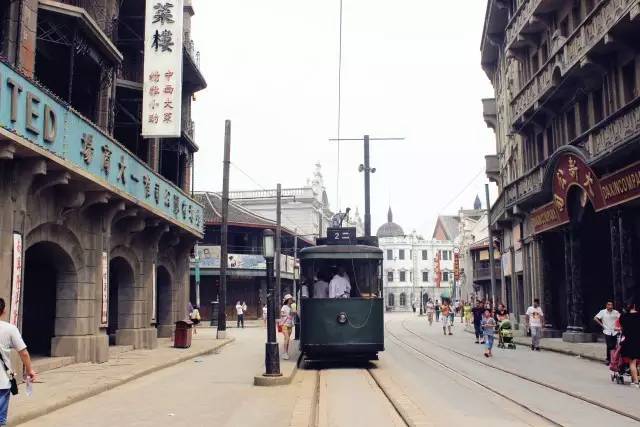 The concession is a must to mention whenever colonial culture of Shanghai is referred to. Prof. Lee mentioned that there were many new books and cultures in the concession so that missionaries would write dictionaries and set up libraries in it. Therefore, Shanghai brought a lot more resources to the literati, who frequently went to the concession as well. A group of Chinese writers then, such as Wangshu Dai and the like, showed their distinct favor to the French Concession, regarding it as the real Paris. People from the present Shanghai, though, prefer to depict figures from the middle and lower classes, or live in the alleys, which are quite ex parte. Eileen Chang, for example, depicted life in Shanghai with half of her stories in the alleys while she lived in an apartment in the British Concession, indicating the partiality of her description. In fact, rich and colorful lives could be found in Shanghai in the 1930s. Numerous scholars as there were, they only wrote something superficial on people's lives.
The concession is a must to mention whenever colonial culture of Shanghai is referred to. Prof. Lee mentioned that there were many new books and cultures in the concession so that missionaries would write dictionaries and set up libraries in it. Therefore, Shanghai brought a lot more resources to the literati, who frequently went to the concession as well. A group of Chinese writers then, such as Wangshu Dai and the like, showed their distinct favor to the French Concession, regarding it as the real Paris. People from the present Shanghai, though, prefer to depict figures from the middle and lower classes, or live in the alleys, which are quite ex parte. Eileen Chang, for example, depicted life in Shanghai with half of her stories in the alleys while she lived in an apartment in the British Concession, indicating the partiality of her description. In fact, rich and colorful lives could be found in Shanghai in the 1930s. Numerous scholars as there were, they only wrote something superficial on people's lives.
 Sadly, as Prof. Lee pointed out, such abundant legacies were pushed over after the Liberation War, when people were forced to forget the history and believe the existence of a decadent Shanghai. Dancing girls and dance halls disappeared, so did the culture of Shanghai. Things have changed since 1990 when government intended to build Shanghai as an international metropolis after the issuance of Pudong development plan. In previous concepts, a city turns a “space” into a “place” by adding humane elements. In the theory of globalization, however, a new city concept turns a“place" into a “non-place”.
Sadly, as Prof. Lee pointed out, such abundant legacies were pushed over after the Liberation War, when people were forced to forget the history and believe the existence of a decadent Shanghai. Dancing girls and dance halls disappeared, so did the culture of Shanghai. Things have changed since 1990 when government intended to build Shanghai as an international metropolis after the issuance of Pudong development plan. In previous concepts, a city turns a “space” into a “place” by adding humane elements. In the theory of globalization, however, a new city concept turns a“place" into a “non-place”.
 According to globalization, cities are to be the center of the world with similar functions. Their cultural productions are for consumption, while city landscapes can be artificially built. Fortunately, most of the outstanding architecture designers in Shanghai oppose to this idea. They hope to make use of the abolished from the old Shanghai and change them into something culture-related, recalling people of their forgotten Shanghai cultures. Colonial cultures have now become an indispensable part of the old Shanghai culture. What Shanghai needs to do, in order to forge a city of culture, is to blend them in.
According to globalization, cities are to be the center of the world with similar functions. Their cultural productions are for consumption, while city landscapes can be artificially built. Fortunately, most of the outstanding architecture designers in Shanghai oppose to this idea. They hope to make use of the abolished from the old Shanghai and change them into something culture-related, recalling people of their forgotten Shanghai cultures. Colonial cultures have now become an indispensable part of the old Shanghai culture. What Shanghai needs to do, in order to forge a city of culture, is to blend them in.
Recommended Readings
1. “Shanghai Modern: The Flowering of a New Urban Culture in China, 1930-1945”, written by Leo Ou-fan Lee
2. “Fin-de-Siècle Vienna: Politics and Culture”, written by Carl E. Schorske
3. “Shanghai”, written by Riichi Yokomitsu
4. “Midnight”, written by Dun Mao
5. “La Condition Humanie”, written by André Malraux
6. “The Song of Eternal Sorrow”, written by Anyi Wang
7. ”Fun Life in the Apartment“, written by Eileen Chang
8. “Foxtrot in Shanghai”, written by Shiying Mu
9. “Flowers”, written by Yucheng Jin

